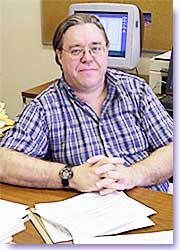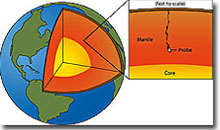David Stevenson

David Stevenson in his office.

Over a hundred years ago, French science fiction writer Jules Verne wrote a novel called Journey to the Center of the Earth, in which a team of explorers descends below the ground, deep inside the Earth. David Stevenson has thought of a way to someday make Verne’s dreams a reality. Maybe.
Stevenson, a physicist at the California Institute of Technology (Caltech), wrote a paper in the prestigious scientific journal Nature describing a way to send an unmanned probe to explore the Earth’s core. “Before, people thought this was a ridiculous idea,” he said. “I hope that I’ve shifted the viewpoint from ridiculous to merely unlikely.”
Studying the Earth’s interior could help answer many scientific questions, such as the origin of Earth’s magnetic field. Even though these questions are just as interesting as those that missions to Mars or Jupiter can answer, Earth’s interior has received a tiny fraction of the attention that other planets have received. Robotic probes have gone as far as Neptune, 500 million km (300 million miles) away, but people have dug only 10 km (6 miles) down in the Earth. Stevenson’s theory could get a probe to the top of the Earth’s core, 4,000 km (2,500 miles) beneath the surface.
He imagines starting with a long, narrow crack filled with 100,000,000 kg (110,000 tons) of liquid iron—as much iron as produced by all the refineries in the world in one hour. The weight of the iron would cause it to fall toward the Earth’s center, cracking the rock beneath, and therefore causing the crack to extend downward. Above the iron, pressure would cause the crack to seal itself. In theory, the crack would continue extending below and sealing above until it reached the top of the Earth’s outer core, where the iron would join the liquid iron that is there naturally.
If a probe the size of a grapefruit were placed in the liquid iron at the surface, it would ride along with the iron, getting to the core in about a week. When it got there, the probe could measure the core’s temperature, pressure, and chemical composition. The probe would melt after about a day in the outer core – a short time, but still longer than NASA’s Galileo probe lasted in Jupiter’s atmosphere. The Earth probe could communicate its information by creating tiny artificial earthquakes that could be detected from the surface.
Stevenson isn’t sure what the probe might find, but he knows it will be interesting. “Whenever we go to planets, we are always surprised,” he says. “I can’t tell you what we’re going to find [in the core], but I know we’ll be equally surprised.”
Of course, this idea has many potential problems – for example, the iron might stick to the walls of the crack, stopping the probe’s downward progress. However, Stevenson believes that scientists and engineers can meet the challenges of actually building his dream, just as they once built the space program and the Manhattan Project.
Stevenson developed his interest in scientific exploration while growing up in New Zealand. There, he read science fiction authors like Isaac Asimov, Robert Forward, and Fred Hoyle. After finishing university in New Zealand, he came to Cornell University in Ithaca, New York, to study physics. At Cornell, he took classes with famous science fiction and science writer Carl Sagan. Stevenson knew he was interested in science, but “I had no idea what I would end up doing,” he said. He started studying the interior of Jupiter and fell in love with the idea of using physics to understand Earth and other planets. “It’s a playground for the application of physics,” he says. Today, his research focuses on the formation of the Earth’s core and on understanding data from NASA’s missions to Jupiter and Saturn. He works on Caltech’s campus in Pasadena, CA, and lives in the San Gabriel Foothills above the city. He rides his bicycle down and up the hills, four miles each way, as he commutes to and from work.
Stevenson’s physics research and his interest in science fiction worked together to inspire his plan to visit the core. He says that parts of the idea have been in his mind for twenty years, but he decided to write it down after the producers of the science fiction film The Core contacted him. The producers wanted Stevenson’s comments on the science depicted in the film. He says that the main premise of the film is sheer fantasy – the high pressures inside the Earth would crush a manned vehicle – but many aspects of the movie really were accurate. Stevenson wrote his entire paper on New Year’s Eve 2002, and it was published in Nature in May.
Stevenson’s proposal has been covered by magazines and newspapers, and has been discussed around the world. “Many scientists find it amusing, and that’s what I expected. But some people find it interesting.” Stevenson points out that many ideas once considered “science fiction” are today part of daily life. Even some of Jules Verne’s impossible ideas have come true. A year after Journey to the Center of the Earth, he wrote another novel – From the Earth to the Moon.











